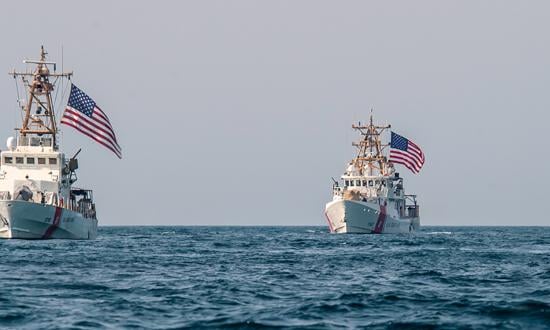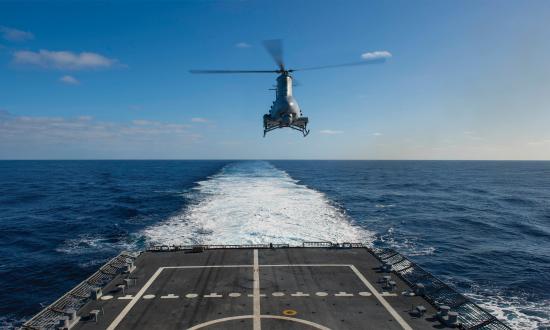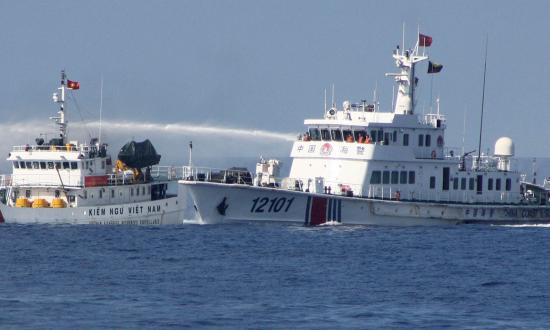Some naval analysts have hypothesized that Chinese activities in the South China Sea are an insurgency.1 As a counter, they propose creating “a numerically large maritime counterinsurgency force of small vessels . . . supported by agile logistics, land-based aircraft, and a reserve of higher-end combatants to serve as a reaction force in case of attack.”2
While others have challenged this characterization, certain current Chinese activities are similar to insurgencies.3 Through that lens, the Navy might gain insights from examining past insurgencies and its counterinsurgency policies and operations. One such example would be the Vietnam War.4
Talking the Talk
During the Vietnam War, the Navy taught counterinsurgency theory to personnel deploying in-country. The theory asserted that comprehensive maritime counterinsurgency—to deter, reassure, and fight—included five principal lines of effort:
• Population and resources control (including surveillance and interdiction)
• Environmental improvement (including humanitarian assistance and disaster relief)
• Guerrilla and counterguerrilla operations
• Psychological operations
• Intelligence and counterintelligence
Population and resources control operations were aimed at splitting the Viet Cong insurgents from the civilian populations on whom they preyed. In the maritime counterinsurgency campaign, this included disrupting and terminating their local coastal and riverine supply lines through constant patrolling, especially along Vietnam’s extensive coastline and myriad inland waterways. A flotilla of small coastal craft, especially Navy PCF “Swift” boats, Coast Guard patrol boats, and South Vietnamese Navy Yabuta junks, checked hundreds of sampans, fishing boats, and other civilian small craft for contraband—including weapons and rice—to prevent the civilian populace from supporting the insurgents and the insurgents from intimidating the civilians. U.S. Navy river patrol boats (PBRs) and Vietnamese Navy junks and other small craft performed similar duties on the inland canals and rivers of the Mekong Delta
Environmental improvement operations were aimed at building support among the civilian population for the South Vietnamese government and its allies, especially U.S. forces. This included U.S. and Vietnamese Navy medical and dental civic action programs (MedCAPs and DenCAPs) and assistance in building and repairing schools, orphanages, clinics, and markets.5 The Vietnamese Navy deployed two hospital ships that often provided medical services to needy towns and villages.
Guerrilla and counterguerrilla operations were aimed at defeating the Viet Cong through direct combat.6 This included pitched battles, raids, ambushes, and defense of exposed outposts, frequently using tactics similar to those of the insurgents. For three years, a Mobile Riverine Force of armored and well-armed riverine craft was deployed in the Mekong Delta with a “main battery” composed of elements of the U.S. Army’s 9th Infantry Division. In 1968, then–Commander, U.S. Naval Forces Vietnam, Vice Admiral Elmo Zumwalt repurposed many of the Navy’s coastal and riverine patrol units from population and resources control operations to a series of offensive counterguerrilla campaigns. Their machine guns, mortars, and small arms enabled them to break up Viet Cong concentrations and blast their bunkers along the rivers, as did the deployment of Navy SEALs.
Psychological operations included distributing leaflets explaining South Vietnamese government policies and exposing Viet Cong transgressions, as well as Vietnamese-language broadcasts from loudspeakers mounted on U.S. Navy patrol craft. U.S. and Vietnamese Navy boats carried entertainment groups with a pro-government message to isolated areas and islands. Messages broadcast and distributed in Viet Cong–leaning areas urged the enemy to come over to the government side.
Intelligence operations were crucial to the maritime counterinsurgency effort.7 A network of U.S. Navy intelligence liaison officers sought to provide the essential intelligence to enable U.S. and Vietnamese Navy forces to carry out all these types of operations. They debriefed operators and provided them with intelligence-based analyses of what they were accomplishing.
These five pillars of counterinsurgency warfare formed the theoretical basis for the activities and operations of U.S. Navy forces in and around South Vietnam in the 1960s and 1970s. Updated (for example, to account for unmanned aerial vehicles [UAVs], social media, data analytics, artificial intelligence, etc.), they could provide a useful initial framework for planning a counterinsurgency campaign in the South China Sea.
Walking the Walk
The chief takeaway from the Vietnam War: The Navy needed—and still needs—a lot more than theory and small combatant ships and craft to prosecute a maritime counterinsurgency campaign. Some of the most important elements were and continue to be:
• Diplomacy
• Air superiority
• Logistics
• U.S. Coast Guard
• U.S. Marine Corps
• Special operations
• Language and cultural mastery
• Training
Diplomacy is a necessary underpinning of any counterinsurgency campaign. The diplomatic effort to gain access to host nations rimming the South China Sea will be all-important. Two historical examples—Admiral Harry Yarnell’s pre–World War II Asiatic Fleet and the Marine Corps’ Combined Action Platoon (CAP) program in Vietnam—have been cited as successful U.S. counterinsurgency efforts, but both enjoyed unique diplomatic circumstances.8 For Admiral Yarnell, the “unequal treaties” that had opened China to the West allowed his forces to operate in Chinese waters as if the Chinese government did not exist; the Philippines were sovereign U.S. territory a relatively short distance away; and friendly British Hong Kong was nearby and always available. In South Vietnam, special diplomatic arrangements—status of forces agreements and rules of engagement—allowed the Marine Corps to operate as it saw necessary. It did not have to ask anyone’s permission to set up CAP teams.
But the South China Sea today is ringed with sovereign nations, at least some of which would have to grant permission for U.S. Navy operations in the area, especially if supported from a land base or in territorial waters. Such arrangements take time to negotiate and will be different for different nations. To face off against the Chinese, the Navy must start work now.
Diplomatic efforts can yield valuable operational partnerships with third countries as well, lessening the strain on stretched-thin U.S. forces. In Vietnam, U.S. forces were supplemented by allied forces from Korea, Australia, New Zealand, Thailand, the Philippines, and other “Free World Military Forces.” The current triservice maritime strategy, Advantage at Sea, asserts that “alliances and partnerships remain our key strategic advantage.”9 The U.S. Indo-Pacific Strategy suggests like-minded allies and partners who could be approached diplomatically to support U.S. counterinsurgency operations in and around the South China Sea.10
More allies and partners will mean more—and more complex—diplomacy.
Air superiority is a necessity for counterinsurgency, especially for surveillance, force protection, and logistics. In Vietnam, Navy coastal and riverine forces could not have operated successfully without the air cover provided by the Seawolves’ UH-1 helicopters and the Black Ponies’ OV-10 fixed-wing aircraft and “on-call” aviation from other services. Today’s and tomorrow’s warcraft will have their own UAVs, but they can carry only a limited number. Where will additional air support come from? If land-based aircraft, where will they be able to fly from? Manned or unmanned? Lighter than air or heavier than air? U.S. amphibious and logistics ships at sea? The options will have to be sorted through and analyzed—and decisions made.
Logistics is vital to counterinsurgency. How will the logistics chain work? This will be a thorny and complex issue for the Navy: Small craft do not carry 90 days of sustainability. They have to be constantly resupplied—sometimes daily—from someplace. And those places need to be defended, too. In Vietnam, there was a robust network of small bases and a plethora of repurposed World War II logistics and amphibious ships taken out of mothballs to act as floating bases (all in need of their own force protection forces).11 “Agile logistics” will require much fleshing out to implement.12
The U.S. Coast Guard must be involved. During the Vietnam War, Coast Guardsmen ran and manned one of the Navy’s coastal patrol task groups, using their own patrol boats, and provided advice to the Vietnamese Navy’s Fourth Coastal Zone commander. In addition, brand new blue-water high-endurance cutters often deployed to Vietnamese waters to provide naval gunfire support, as well as MedCAPs and DenCAPs in coastal communities.
Today, the example most often cited as Chinese insurgency in the South China Sea is the harassment of local fishermen.13 Few in the Navy have the level of knowledge and experience in dealing with fishermen—and enforcing the law at sea—as do U.S. Coast Guardsmen. While it may make sense for a counterinsurgency campaign in the South China Sea to be an element of a larger Navy-led counter-Chinese maritime campaign, Coast Guard human and material resources should be tapped heavily in protecting local fishermen. Indeed, it is current national security policy to have the Coast Guard play a prominent role in such operations.14 And it is current Navy and Coast Guard policy to foster more integrated naval operations and activities.15
U.S. Marine Corps cooperation will be needed. In Vietnam, Marines conducted much of the air and ground campaign in I Corps, the northernmost part of South Vietnam, supported by a massive Navy logistics command. But in the maritime campaigns in the Mekong Delta in the far south, the Navy operated far more closely with the U.S. Army. All concerned made these arrangements work, but a better solution for a counterinsurgency campaign in the South China Sea would be Navy–Marine Corps integration. The Marine Corps has focused on potential South China Sea operations in its games, exercises, and force development.16 It stands to reason that any South China Sea campaign will be a campaign by all the Sea Services, as well as partners and allies.
Special operations forces support may be required, especially if direct military combat occurs. The Navy’s counterinsurgency effort in South (and sometimes North) Vietnam heavily involved the underwater demolition teams and SEAL teams. Confrontations at sea between Chinese “fishermen,” host nationals, third parties, and U.S. Navy small surface combatants could deteriorate into violence. The special skills and rapid reaction times of Marines and naval special warfare forces will be invaluable but will need to be planned for and exercised.
Language and cultural mastery is a force multiplier in counterinsurgency.17 One of the great issues in Vietnam was the periodic lack of understanding between U.S. Navy personnel and their South Vietnamese Navy allies, as well as the Vietnamese civilians with whom they interacted during patrols. The Vietnamese usually understood U.S. Navy personnel pretty well, since they lived and worked with a succession of U.S. advisors. Americans’ exposure to the Vietnamese was much more rudimentary: usually only a one-year tour and often less. Predeployment language and cultural training could only scratch the surface, and in-country cultural and interpersonal relations training programs had to be instituted to equip Navy personnel with the necessary skills, knowledge, and attitudes to bridge cultural gaps.
In those days, there were no Navy foreign area officers (FAOs) outside a few self-educated individuals (on whom Navy commanders leaned heavily). For a South China Sea counterinsurgency campaign, it will be necessary to train a small Navy force with language and cultural skills sufficient to advise their shipmates and commanders. Failure to do so will result in attitudes and misunderstandings that could jeopardize the entire effort. Consequently, the FAO program needs to give adequate weight to expertise in the languages and cultures of South China Sea countries, as well as allied navies that could be expected to operate there alongside the United States.18
Specialized training is required for counterinsurgency. During the Vietnam War, the Navy set up predeployment training programs and facilities at Naval Amphibious Bases Coronado and Little Creek, as well as riverine training at the Naval Inshore Operations Training Center at Mare Island, California, and coastal patrol Swift boat training at Coronado. Prospective advisors—who would engage most heavily with the Vietnamese—got a 13-week course of academics and language, weapons, and survival, evasion, resistance, escape (SERE) training. Some billets required more.
Such training is expensive—in money, time, and opportunity costs. The predeployment training pipeline for advisors took up to 4 months, to prepare for a tour lasting only 12 months, and required a large staff composed mostly of seasoned Vietnam veterans. And it played havoc with orderly career progressions for officers and enlisted men, who would seldom use much of that training again. Training facilities, curricula, staffing, and pipelines will need to be considered before embarking on any counterinsurgency campaign in and around the South China Sea.
The Navy also mounted a massive training program for Vietnamese Navy personnel in the late 1960s and early 1970s, to enable turnover of naval operations, bases, warships and equipment. Since responsibility for protecting local fishermen and other civilian mariners at sea rests principally with the host government—and its own navy and coast guard—the U.S. Navy and Coast Guard should endeavor to train their host navy counterparts in counterinsurgency skills: in-country, offshore, and in U.S. schools. This will cost money.
A Complex Endeavor
Counterinsurgency is a complex and difficult endeavor. It involves multiple lines of effort and will require Navy surface warfare officers manning small surface combatants such as littoral combat ships and the Mark VI patrol boat, as well as diplomats, aviators and aircraft, logisticians, Marines, Coast Guardsmen, special operations forces, FAOs, and significant investments in logistics and training infrastructure.
All the factors that will be involved in achieving a victory must be considered, analyzed, and resourced.
1. Hunter Stires, “The South China Sea Needs a ‘COIN’ Toss,” U.S. Naval Institute Proceedings 145, no. 5 (May 2019); Hunter Stires, “Win Without Fighting,” U.S. Naval Institute Proceedings 146, no. 6 (June 2020); and Hunter Stires and CAPT Dan Straub, USN, “Littoral Combat Ships and Maritime COIN,” U.S. Naval Institute Proceedings 147, no. 1 (January 2021).
2. Stires, “The South China Sea Needs a ‘COIN’ Toss,” 21.
3. Lawrence Sid Trevathan, Comment and Discussion: “The South China Sea Needs a ‘COIN’ Toss,” U.S. Naval Institute Proceedings 145, no. 7 (July 2019); LCDR Brian Hayes, USNR, Comment and Discussion: “The Other Side of the COIN,” U.S. Naval Institute Proceedings 147, no. 4 (April 2021).
4. My experience with insurgency and maritime counterinsurgency goes back some 50 years or so, when the Vietnam War was in full cry. I studied counterinsurgency in college and graduate school; taught maritime counterinsurgency to Vietnam-bound officers and enlisted men (and a few women) during my first tour in the Navy; then volunteered for duty in-country for two tours, in 1969 and 1970. I served in U.S. Naval Forces Vietnam (NAVFORV), a command deploying hundreds of specialized coastal and riverine craft and aircraft, operating alongside other hundreds of South Vietnamese warcraft, mostly conducting counterinsurgency operations of some type in and near the South China Sea. Subsequently, as a career Navy strategist in uniform and then a naval analyst at CNA, I periodically was asked to contribute to analyses that drew on this education and experience.
5. On MedCAPs and DenCAPs, see Jan K. Herman, Navy Medicine in Vietnam: Passage to Freedom to the Fall of Saigon (Washington, DC: Department of the Navy, 2010).
6. See, for example, Edward J. Marolda and R. Blake Dunnavent, Combat at Close Quarters: Warfare on the Rivers and Canals of Vietnam (Washington, DC: Department of the Navy, 2015).
7. See Richard A. Mobley and Edward J. Marolda, Knowing the Enemy: Naval Intelligence in Southeast Asia (Washington, DC: Department of the Navy, 2015).
8. Stires, “The South China Sea Needs a ‘COIN’ Toss,” 19–21.
9. Department of Defense, Advantage at Sea: Prevailing with Integrated All-Domain Naval Power (Washington, DC: December 2020), 6.
10. Indo-Pacific Strategy of the United States (Washington, DC: The White House, February 2022), 13.
11. On the enormity of this effort, see Salvatore R. Mercogliano, Fourth Arm of Defense: Sealift and Maritime Logistics in the Vietnam War (Washington, DC: Department of the Navy, 2017).
12. Mercogliano, Fourth Arm of Defense.
13. See especially, Stires and Straub, “Littoral Combat Ships and Maritime COIN,” 21
14. Indo-Pacific Strategy of the United States, 17.
15. U.S. Department of Defense, Advantage at Sea.
16. Stires, “The South China Sea Needs a ‘COIN’ Toss,” 20–21.
17. See RADM Paul Becker, USN (Ret), Comment and Discussion: “Littoral Combat Ships for Maritime COIN,” U.S. Naval Institute Proceedings 147, no. 3 (March 2021), 9, 89.
18. For a recommendation that the Coast Guard establish a FAO program as well, see LCDR Keith Wilkins, USN, and Diana Moyseowicz, “Deckplate Diplomats: Invest in Coast Guard FAOs,” U.S. Naval Institute Proceedings 148, no. 2 (February 2022).










